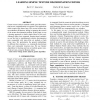Free Online Productivity Tools
i2Speak
i2Symbol
i2OCR
iTex2Img
iWeb2Print
iWeb2Shot
i2Type
iPdf2Split
iPdf2Merge
i2Bopomofo
i2Arabic
i2Style
i2Image
i2PDF
iLatex2Rtf
Sci2ools
70
Voted
ICIP
2010
IEEE
2010
IEEE
Learning simple texture discrimination filters
Current texture analysis methods enable good discrimination but are computationally too expensive for applications which require high frame rates. This occurs because they use redundant calculations, failing in capturing the essence of the texture discrimination problem. In this paper we use a learning approach to obtain simple filters for this task. Although others have proposed learning-based methods, we are the first to simultaneously achieve discrimination rates comparable with state-of-the art methods at high frame rates. We particularize the general methodology to different filter structures, e.g., rotationally discriminant filters and rotationally invariant ones. We use Genetic Algorithms for learning and test our method against stateof-the-art ones, using the Brodatz album.
Current Texture Analysis | ICIP 2010 | Image Processing | State-of-the Art Methods | Texture Discrimination Problem |
Related Content
| Added | 12 Feb 2011 |
| Updated | 12 Feb 2011 |
| Type | Journal |
| Year | 2010 |
| Where | ICIP |
| Authors | Rui F. C. Guerreiro, Pedro M. Q. Aguiar |
Comments (0)

